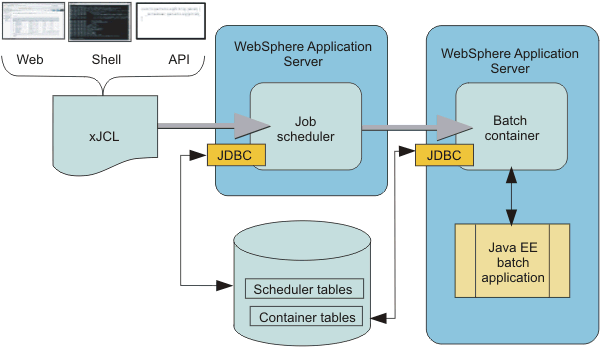Understanding the elements in the batch environment
A typical batch environment consists of a job scheduler, batch container, batch applications, jobs, interfaces for management functions, and database tables.
The following diagram depicts the elements of the basic batch environment:
Figure 1. The batch elements

The following list describes the items in the diagram:
- Job scheduler
The job scheduler is the batch component that provides all job management functions, such as submit, cancel, and restart. It maintains a history of all jobs, including those waiting to run, those running, and those having already run. The job scheduler is hosted in an application server. In a Network Deployment environment, the job scheduler can also be hosted in a cluster.
- Batch container
The batch container is the batch component that provides the execution environment for the batch jobs. Java EE based batch applications run inside the batch container. The batch container is hosted in an application server. In a Network Deployment environment, the batch container can also be hosted in a cluster.
- Java EE batch application
Java EE batch applications are regular Java EE applications, deployed as Enterprise Archive (EAR) files, that contain implementations of one or more Java batch applications. These Java batch applications follow either the transactional batch or compute-intensive programming models.
- xJCL
Jobs are described using a job control language. The batch jobs use an XML-based job control language. The job description identifies which application to run, its inputs, and outputs.
- Web, Shell, API
The job scheduler exposes three API types to access its management functions: A web interface called the job management console, a shell command line called lrcmd, and APIs, available as either web services or EJBs.
- Scheduler tables
The job scheduler uses a relational database to store job information. It can be any relational database supported by WebSphere Application Server. If the job scheduler is clustered, the database must be a network database, such as DB2 .
- Container tables
The batch container uses a relational database to store checkpoint information for transactional batch applications. The database can be any relational database supported by WAS. If the batch container is clustered, the database must be a network database, such as DB2.
- JDBC
The JDBC is standard JDBC connectivity to the scheduler and container tables, as supported by the WAS connection manager.
Related: